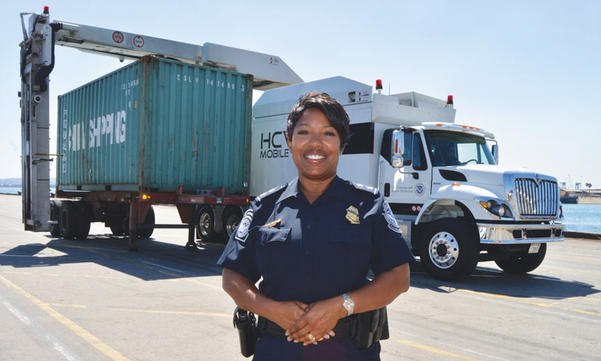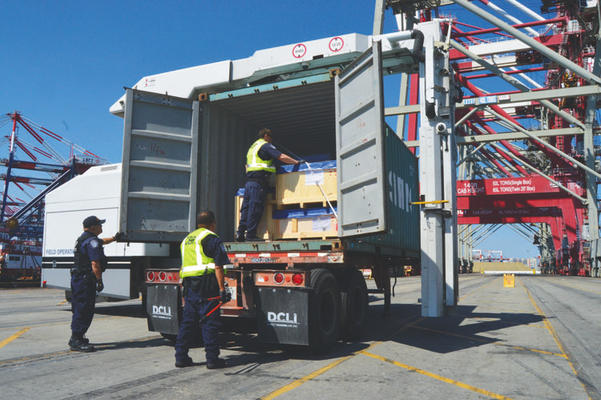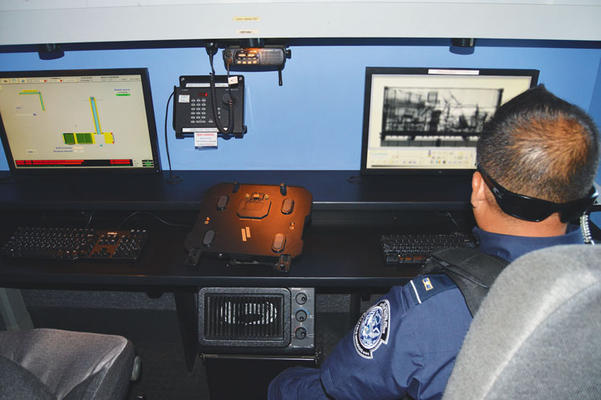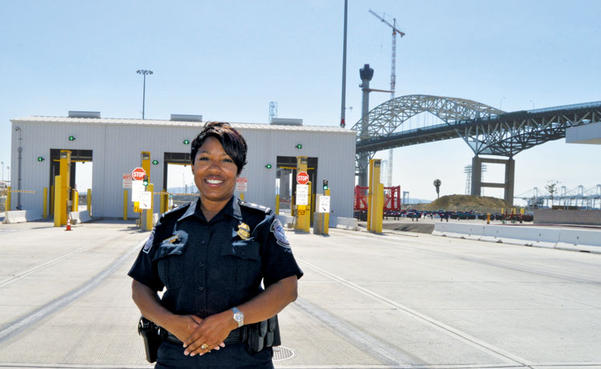LaFonda Sutton-Burke is not a person who waits for things to happen. Her career has been a series of strategic steps – volunteering for unwanted positions, growing her experience and education to advance, and opening doors that others might not even think to approach.
Once a key punch operator at an Air Force base, on July 26 Sutton-Burke is officially taking on the role of port director of the Los Angeles, Long Beach and Hueneme seaports for U.S. Customs and Border Protection (CBP) – a senior executive service level position that puts her governmental rank just below presidential appointees.

LaFonda Sutton-Burke is taking on the role of port director for U.S. Customs & Border Protection’s Los Angeles/Long Beach/Port Hueneme seaports division on July 26. She is the first African-American woman to hold this position. (Photograph by the Business Journal’s Larry Duncan)
The Los Angeles and Long Beach ports combined are the 10th largest port complex in the world and the largest in the United States. More than a third of the nation’s goods come through L.A./Long Beach. In 2016, $278 billion in merchandise came through the ports. Port Hueneme, located 70 miles north, is a vital port of entry for bulk cargo, particularly agricultural imports like bananas.
For the past six months, Sutton-Burke has been working from the CBP’s Long Beach office, spending her time getting to know terminal operators and government stakeholders like port staff and leaders of other regional federal branches like the U.S. Coast Guard, while familiarizing herself with her staff of more than 660 employees.
Ahead of her official start date, Sutton-Burke spoke with the Business Journal in CBP’s Downtown Long Beach offices and reflected on her journey from being a low-level government employee to the first African-American woman to serve as the regional CBP port director.
Sutton-Burke began her government career as a keypunch operator at Tinker Air Force Base while studying general education at the University of Central Oklahoma. Laughing, she said, “[I thought] the heavens and the skies were going to open up because I had my degree.” But they did not. “Even with a degree, I had to basically reinvent myself. And being from humble beginnings . . . I joined the reserves and went into logistics.”
Sutton-Burke volunteered to take part in Operation Desert Shield, a 1990 effort ordered by then-President George H. W. Bush in response to Iraq’s invasion of Kuwait. “I went to Dhahran, Saudi Arabia, and basically retrograded the cargo and the equipment that was in theater back to the United States and Germany. Again, trying to get that leadership managerial type of skillset that I could actually market,” she said, noting that she was a second lieutenant logistics officer.
In 1992, Sutton-Burke applied to what was then called the U.S. Customs Service (after 9/11, customs and border protection were combined into CBP). “It was an all-female roster because they were trying to recruit more women to come in. And I was fortunate enough to get an interview and was offered a position in El Paso, Texas,” she recalled. “[It was] 130 degrees when I arrived.”
“It was amazing, but I have to be honest. I really was just looking for an opportunity, a career ladder,” Sutton-Burke said. “I saw a lot of potential when I got into the service, especially on the southern border. And I saw that there were opportunities.”
To climb the career ladder, Sutton-Burke volunteered for everything. She views one such move in particular as the decision that set her on the course to where she is today. “I volunteered to go to Laredo, Texas. You can always see the crossroads, and that was it,” she said. “No one wanted to go to Laredo. They were like, there is nothing in Laredo.”

U.S. Customs & Border Protection officers at the Port of Long Beach enter a container that has been scanned by an X-Ray device affixed to a truck, as shown here. (Photograph by the Business Journal’s Larry Duncan)
In Laredo, Sutton-Burke worked on the development of a customs targeting system – a multi-pronged strategy for determining what cargo and persons entering or exiting the country were in need of more detailed screening. “I worked cargo, and I developed a curriculum for this southern border interdiction training for targeting. It was a passenger analytical and a cargo analytical targeting course,” she explained. Doing so introduced her to the manager of Customs’ headquarters, who a year later selected her for a role in Washington, D.C.
After advancing through the ranks, Sutton-Burke became director of the nonintrusive inspection division (NII) at CBP headquarters in D.C. in 2012. She served in that role and oversaw $4.6 billion of NII technology at 320 ports of entry used by 52,000 CBP officers and agents until her selection as port director last year. In that time, she became familiar with the ports of Long Beach and Los Angeles through her collaboration with them on capital improvement projects such as the Middle Harbor Redevelopment Project for Long Beach Container Terminal.
In a post-9/11 world, CBP’s role at the ports is to ensure nothing nefarious or illicit enters or exits the country, while keeping the flow of goods moving safely and smoothly. “I will say 99% of the cargo that comes in is legitimate trade and travel. And that has always been our mission – to facilitate legitimate trade and travel,” Sutton-Burke said. “But also, we have that balancing act of national security.”
Every container entering and exiting the port complex is screened for radioactive isotopes, considering “everything that’s going on in the world today,” Sutton-Burke noted.
The biggest threats to national security that the CBP encounters are illicit activities by transnational organized crime, according to Sutton-Burke. “Transnational crime could be anything from [infringement of] intellectual property rights [to] pirated goods. Those funds are then used to fund criminal organizations,” she explained.
Intellectual property rights violations often include counterfeit goods such as designer purses, textiles, cigarettes and more. “Then also, there is an export aspect of this operation because there are organizations that are also exporting currency and weapons,” Sutton-Burke said.
“We also have a bio-agricultural issue where . . . companies can bring in agriculture products that could actually shut down our whole agro economy,” Sutton-Burke continued. “We just intercepted khapra beetles coming in on a shipment of, I think, kiwis. . . . And the impact to the economy would have been devastating.” Khapra beetles are an invasive species that pose a great risk to seeds and grains.
In addition to funding criminal organizations, these threats pose economic risks to the United States and affect the competitiveness of American businesses, according to CBP. And in some cases – for instance, with toys made with lead – they pose health threats to the American public.
Narcotics are also always a concern, and a growing opioid-abuse problem in the United States is playing into that, according to Sutton-Burke. “We are seeing narcotics being a major issue,” she said.

A U.S. Customs & Border Protection officer reviews the X-ray scan of the inside of a shipping container located outside his van, which the massive X-ray device is attached to, at the Port of Long Beach. (Photograph by the Business Journal’s Larry Duncan)
“The number one concern definitely is ensuring that terrorists and implements of terror are not entering,” Sutton-Burke said.
CBP works with many other entities to ensure these risks are evaded, including private partners like terminal operators and other public agencies like the U.S. Drug Enforcement Agency and the U.S. Department of Agriculture, according to Sutton-Burke.
All cargo arriving in the United States is screened electronically. Ships’ manifests and other data are run through a process that weeds out shipments for further inspection. “We are moving and are continuing to move into the 21st century using more electronic means, more algorithms, trying to basically again screen as much as we can 100% and then segment the high-risk shipments out from the low-risk shipments based on algorithms that have been developed at the targeting center,” Sutton-Burke said.
A common way criminals try to thwart CBP officers is by misclassifying their shipping manifests. According to spokesperson Jaime Ruiz, such criminals will often pile legitimate goods at the opening of a container and attempt to hide illegitimate goods at the container’s rear. “There is a lot of information that is manifested that is not true. . . . So we don’t take at face value what is declared,” he said.
CBP has a wide range of equipment to inspect shipments, including X-ray machines large enough to scan containers, gamma ray scanners and a variety of handheld technologies.
“The bottom line is, the most critical layer of the enforcement strategy is the officers and the agriculture specialists. . . . It’s the humans that are boots on the ground that are working at the piers, that are conducting the inspections, working at the cruise terminal,” Sutton-Burke said.
The technology supplied to those officers is considered force-multipliers. “If you do a manual exam of a 40-foot container, a 40-foot container holds about a three-bedroom house. It can take 120 minutes,” Sutton-Burke said. “But you can use one of the large-scale X-ray systems, and you can scan that 40-foot container in eight minutes. So that’s another part of the layered enforcement strategy.”
There are multiple opportunities down the line to catch a threat or criminal activity thanks to CBP’s layered enforcement strategy, according to Sutton-Burke. “The layered enforcement strategy is designed [so that] if one node on that strategy misses something, it’ll be picked up from another node. And so that is part of why this type of operation, which could possibly appear overwhelming, is really actually very incredible,” she said.
CBP is also responsible for monitoring the travelers going through cruise terminals in Long Beach and Los Angeles, Sutton-Burke noted. CBP monitors logs and has officers on-site to facilitate legitimate travel and identify illegitimate travel or criminal elements.
Seizures of goods at the seaports increased by 22% from fiscal year 2015 to 2016. In total, the number of seizures grew from 537 to 656, according to CBP data. Many of these included seizures of goods that violated trademarks, Sutton-Burke noted. “It could be the fact that with the growth of cargo coming in, that it’s increasing,” she said, adding that technology has also helped CBP to be more efficient.
“The importance of this is that the global supply chain is not just about CBP. The infrastructure projects that are going on, the growth and the development that California is leading, we are here to be working with them,” Sutton-Burke said. She added that if any private entities intend to pursue capital projects – for instance, Long Beach Container Terminal’s collaboration with the Port of Long Beach to build out Middle Harbor – she would like to be at the table to assist.

LaFonda Sutton-Burke, the new port director for U.S. Customs & Border Protection’s Los Angeles/Long Beach/Port Hueneme seaports division effective July 26, is shown at a truck facility that scans all containers that come into the Port of Long Beach. At right, work continues on the new Gerald Desmond Bridge. (Photograph by the Business Journal’s Larry Duncan)
“We actually meet consistently with terminal owners and operators. We are working with brokers associations, trade associations, container exam stations. So we try to meet locally and work closely with entities around here, including state and local,” Sutton-Burke said.
Partnering with the private sector helps ensure that commerce keeps going. “When 9/11 occurred, everything basically just stopped. That is something we definitely don’t want to occur again. And I think that’s why partnerships also are incredibly important in this whole endeavor,” Sutton-Burke said.
“My top goal really is the mission: ensuring that the country is safe, the American people are safe, our economy is safe. But also ensuring that trade facilitation is balanced with that national security perspective,” Sutton-Burke said.
She noted that recruitment has been challenging for CBP and that she is focused on developing current staff and empowering them to ensure more of them are retained. “To retain staff nowadays, you basically have to ensure that they understand the importance of the culture, but then you also have to give them the opportunities. So I try not to forget what I needed when I was at that level,” she said.
Finally, her goal is to continue to grow partnerships. “I want to ensure that the private entities and the other public entities are aware that we are here to work with them. We are here to be their advocate,” she said.
“We’re here as part of the business community, and we are here to be a partner with the business community. If I can be of any assistance, I am readily available,” Sutton-Burke said.
Sutton-Burke is currently living with her 10-year-old daughter in San Pedro while her husband remains on the East Coast. “We sold the house and now are just trying to look for a permanent place,” she said. “We have been having a great time. It is beautiful weather. I love it.”
